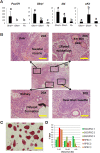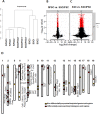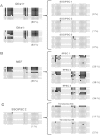Tet-mediated imprinting erasure in H19 locus following reprogramming of spermatogonial stem cells to induced pluripotent stem cells
- PMID: 26328763
- PMCID: PMC4556992
- DOI: 10.1038/srep13691
Tet-mediated imprinting erasure in H19 locus following reprogramming of spermatogonial stem cells to induced pluripotent stem cells
Abstract
Selective methylation of CpG islands at imprinting control regions (ICR) determines the monoparental expression of a subset of genes. Currently, it is unclear whether artificial reprogramming induced by the expression of Yamanaka factors disrupts these marks and whether cell type of origin affects the dynamics of reprogramming. In this study, spermatogonial stem cells (SSC) that harbor paternalized imprinting marks, and fibroblasts were reprogrammed to iPSC (SSCiPSC and fiPSC). The SSCiPSC were able to form teratomas and generated chimeras with a higher skin chimerism than those derived from fiPSC. RNA-seq revealed extensive reprogramming at the transcriptional level with 8124 genes differentially expressed between SSC and SSCiPSC and only 490 between SSCiPSC and fiPSC. Likewise, reprogramming of SSC affected 26 of 41 imprinting gene clusters known in the mouse genome. A closer look at H19 ICR revealed complete erasure in SSCiPSC in contrast to fiPSC. Imprinting erasure in SSCiPSC was maintained even after in vivo differentiation into teratomas. Reprogramming of SSC from Tet1 and Tet2 double knockout mice however lacked demethylation of H19 ICR. These results suggest that imprinting erasure during reprogramming depends on the epigenetic landscape of the precursor cell and is mediated by TETs at the H19 locus.
Conflict of interest statement
The authors declare no competing financial interests.
Figures




Similar articles
-
Role of Tet1 in erasure of genomic imprinting.Nature. 2013 Dec 19;504(7480):460-4. doi: 10.1038/nature12805. Epub 2013 Dec 1. Nature. 2013. PMID: 24291790 Free PMC article.
-
Self-Reprogramming of Spermatogonial Stem Cells into Pluripotent Stem Cells without Microenvironment of Feeder Cells.Mol Cells. 2018 Jul 31;41(7):631-638. doi: 10.14348/molcells.2018.2294. Epub 2018 Jul 10. Mol Cells. 2018. PMID: 29991673 Free PMC article.
-
De Novo DNA Methylation at Imprinted Loci during Reprogramming into Naive and Primed Pluripotency.Stem Cell Reports. 2019 May 14;12(5):1113-1128. doi: 10.1016/j.stemcr.2019.04.008. Epub 2019 May 2. Stem Cell Reports. 2019. PMID: 31056481 Free PMC article.
-
Effects of reprogramming on genomic imprinting and the application of pluripotent stem cells.Stem Cell Res. 2019 Dec;41:101655. doi: 10.1016/j.scr.2019.101655. Epub 2019 Nov 9. Stem Cell Res. 2019. PMID: 31734645 Review.
-
Epigenetic reprogramming in mammalian development.Science. 2001 Aug 10;293(5532):1089-93. doi: 10.1126/science.1063443. Science. 2001. PMID: 11498579 Review.
Cited by
-
Source cell-type epigenetic memory persists in induced pluripotent cells but is lost in subsequently derived germline cells.Front Cell Dev Biol. 2024 Feb 12;12:1306530. doi: 10.3389/fcell.2024.1306530. eCollection 2024. Front Cell Dev Biol. 2024. PMID: 38410371 Free PMC article.
-
Identification of spermatogenesis-associated changes in DNA methylation induced by maternal exposure to chemicals in male germ cells.STAR Protoc. 2022 Dec 16;3(4):101912. doi: 10.1016/j.xpro.2022.101912. Epub 2022 Dec 9. STAR Protoc. 2022. PMID: 36595925 Free PMC article.
-
ZP4 confers structural properties to the zona pellucida essential for embryo development.Elife. 2019 Oct 22;8:e48904. doi: 10.7554/eLife.48904. Elife. 2019. PMID: 31635692 Free PMC article.
-
The Sperm Olfactory Receptor OLFR601 is Dispensable for Mouse Fertilization.Front Cell Dev Biol. 2022 Jun 3;10:854115. doi: 10.3389/fcell.2022.854115. eCollection 2022. Front Cell Dev Biol. 2022. PMID: 35721474 Free PMC article.
-
SMC2 ablation impairs bovine embryo development shortly after blastocyst hatching.Reproduction. 2024 Oct 3;168(5):e240211. doi: 10.1530/REP-24-0211. Print 2024 Nov 1. Reproduction. 2024. PMID: 39231091 Free PMC article.
References
-
- Ferguson-Smith A. C. & Surani M. A. Imprinting and the epigenetic asymmetry between parental genomes. Science 293, 1086–1089 (2001). - PubMed
-
- Labosky P. A., Barlow D. P. & Hogan B. L. Mouse embryonic germ (EG) cell lines: transmission through the germline and differences in the methylation imprint of insulin-like growth factor 2 receptor (Igf2r) gene compared with embryonic stem (ES) cell lines. Development 120, 3197–3204 (1994). - PubMed
-
- Wilmut I., Schnieke A. E., McWhir J., Kind A. J. & Campbell K. H. Viable offspring derived from fetal and adult mammalian cells. Nature 385, 810–813 (1997). - PubMed
Publication types
MeSH terms
Substances
LinkOut - more resources
Full Text Sources
Other Literature Sources
Molecular Biology Databases
Research Materials

